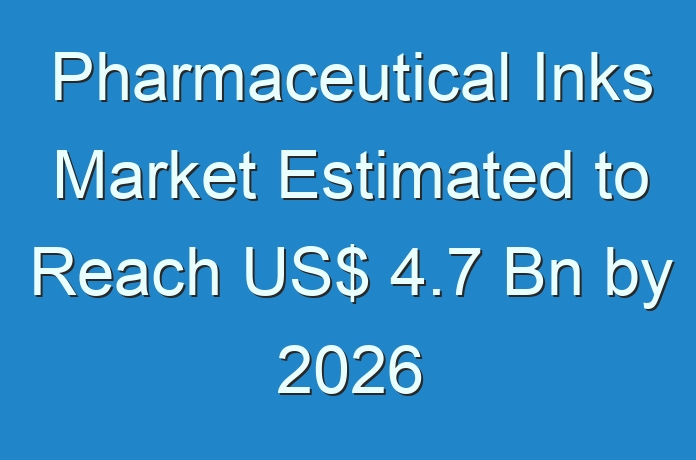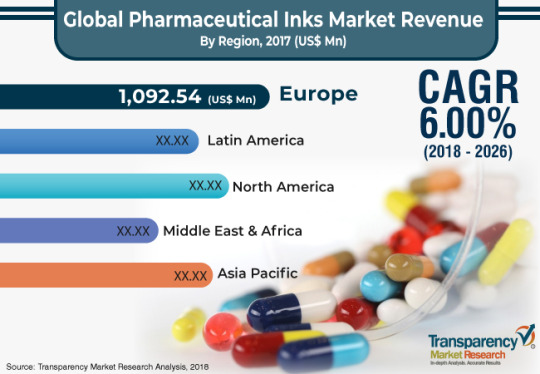
The global pharmaceutical inks market was valued at US$ 2.8 Bn in 2017 and is anticipated to expand at a CAGR of more than 5.0% from 2018 to 2026, according to a new report by Transparency Market Research (TMR) titled ‘Pharmaceutical Inks Market – Global Industry Analysis, Size, Share, Growth, Trends, and Forecast, 2018–2026.’ Pharmaceutical inks are used on pharmaceuticals to print vital information about medicines such as name, manufacturing location, and expiry date. These inks are also used to print designs, logos, and colors on medicines. Furthermore, they are employed in interior and exterior packaging of medicines.

Request A Sample – https://www.transparencymarketresearch.com/sample/sample.php?flag=S&rep_id=60642?
Increase in Health Awareness to Boost Market
Awareness about health is rising rapidly in developing countries such as Brazil, China, and India. Increasing number of people in these countries are able to purchase medicines. Consequently, the consumption of pharmaceuticals has risen in the last few decades. This is directly boosting the consumption of pharmaceutical inks. These inks are used in pharmaceuticals to print important information. They are also used to print designs and colors on medicines. Furthermore, they are employed in interior packaging and exterior packaging of medicines. Thus, the consumption of pharmaceutical inks is expected to increase along with the rise in consumption of pharmaceuticals.
Need to Select Right Solvent
Technological improvement in manufacturing processes and increase in demand for pharmaceuticals have led to faster production of pharmaceuticals. Production of pharmaceutical inks needs to keep pace with the production of pharmaceuticals. Furthermore, these inks need to dry quickly after their application on packaging or medicines. Pharmaceutical ink manufacturers have started employing various solvents to aid the drying process. However, the use of wrong solvents can adversely affect the environment as well as the health of patients consuming pharmaceuticals. Solvents need to be selected after careful consideration. This has adversely affected the development of new pharmaceutical inks, thereby hampering the market.
More Trending Reports by Transparency Market Research – https://www.prnewswire.com/news-releases/fumigation-products-market-volume-sales-set-to-surpass-1-million-tons-by-2027-amidst-adoption-of-digital-technologies-by-key-players-300997528.html
Partnerships between Pharmaceutical Manufacturers and Pharmaceutical Ink Manufacturers to Drive Market
A wide range of pharmaceutical inks are available in the market. This can confuse pharmaceutical manufacturers. However, pharmaceutical ink manufacturers, who employ ink chemists and coding specialists, can help narrow down the choice for pharmaceutical manufacturers by considering various factors such as production environment, weather conditions, material to be printed upon, types of solvents, recyclability, environment-friendly requirements, and pace of manufacturing the inks.
Ask for Discount on Premium Research Report With Complete TOC at – https://www.transparencymarketresearch.com/sample/sample.php?flag=D&rep_id=60642
Global Pharmaceutical Inks Market Segmented Based on Type, Pharmaceutical Type, Application, and Region
In terms of type, the global pharmaceutical inks market has been segmented into water-based, solvent-based, edible inks, and others (including custom solvents). The solvent-based segment accounts for prominent share of the pharmaceutical inks market, as these inks offer advantages such as low cost and efficiency of printing. Based on pharmaceutical type, the market has been segregated into solids, semi-solids, and liquids. The liquids segment holds major share of the market. Liquid pharmaceuticals require large amount of pharmaceutical inks because of the larger surface area covered by their packaging. Based on application, the global pharmaceutical inks market has been classified into capsules, interior packaging, and exterior packaging. The exterior packaging segment constitutes dominant share of the market, considering the wide range of information that needs to be printed. This includes name of the product, company, logos, and manufacturing and expiry details. In terms of region, the market has been split into North America (the U.S. and Canada), Latin America (Brazil, Mexico, and Rest of Latin America), Europe (Germany, the U.K., France, Italy, Spain, Russia & CIS, and Rest of Europe), Asia Pacific (China, India, Japan, ASEAN, and Rest of Asia Pacific) and Middle East & Africa (GCC, South Africa, and Rest of Middle East & Africa). Europe is the prominent consumer of pharmaceutical inks, primarily due to the large amount of pharmaceuticals manufactured and the higher price of pharmaceutical inks in the region.
Request for covid19 Impact Analysis – https://www.transparencymarketresearch.com/sample/sample.php?flag=covid19&rep_id=60642





